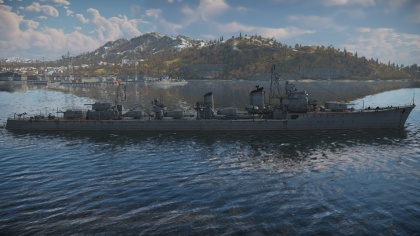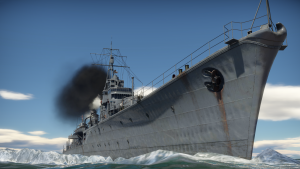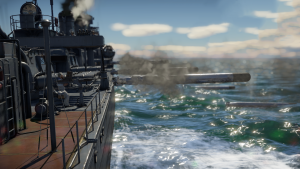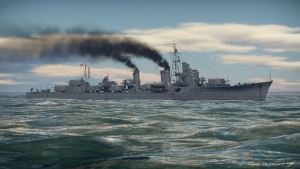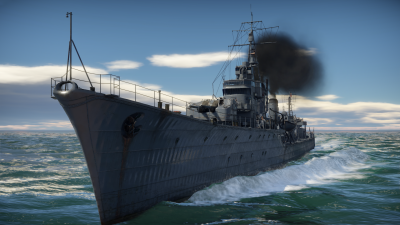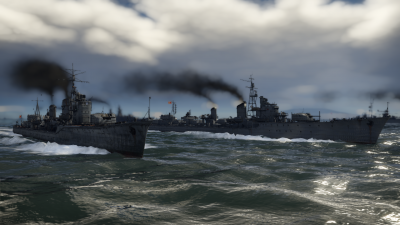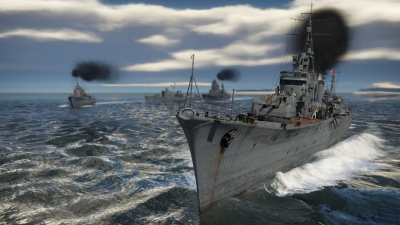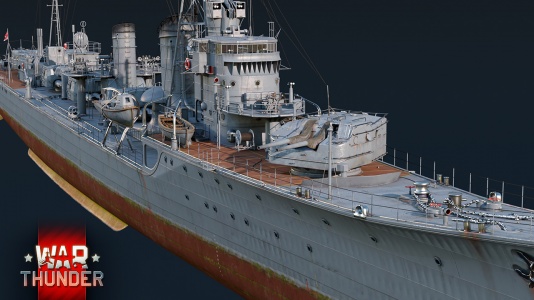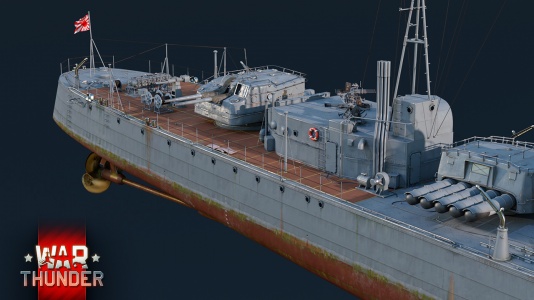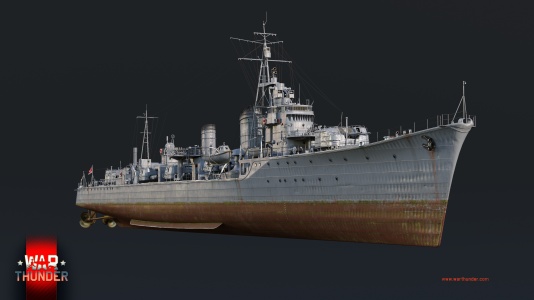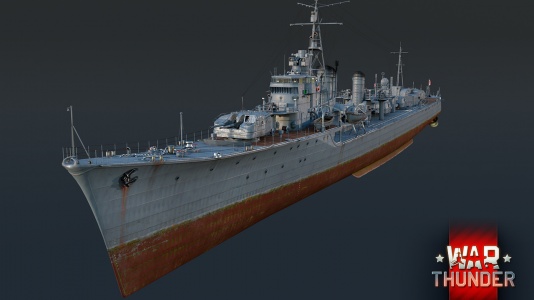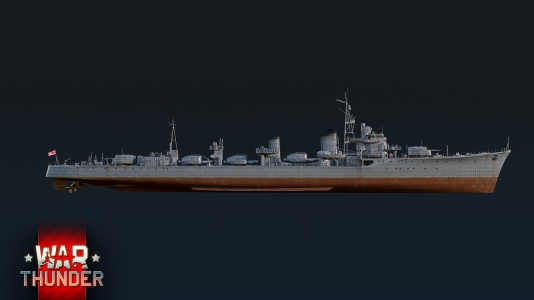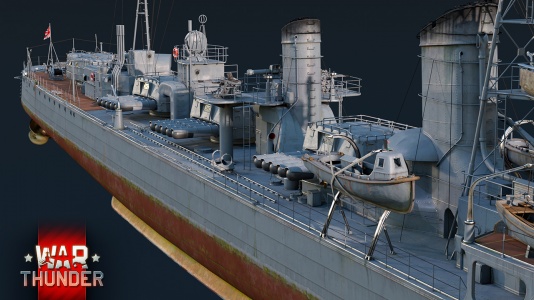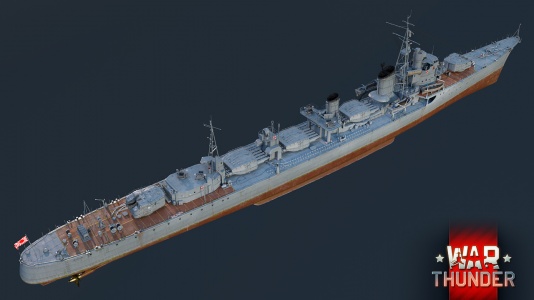IJN Shimakaze
Contents
Description
The Shimakaze-class, IJN Shimakaze, 1944 is a squadron rank Japanese destroyer
with a battle rating of (AB), (RB), and (SB). It was introduced during Update "Raining Fire".
General info
Survivability and armour
Shimakaze is an extended Yugumo-class hull which comparatvily gives her more crew and extra space & displacement for an additional torpedo launcher and other weight, but also higher crew count (+40 men). Additionally her survivability is further is aided by having ammunition stored deep underneath the water line, what ensures survival if faced with AP shells, and having torpedo turrets protected against fragmentation damage, though they are still one of the easiest components to damage on the ship.
That said though, comparing to the equivalents in its BR, the ship has a relatively low crew count, sailing just a 2/3 of the Leningrad men, in a short-range fights Shimakaze has to rely on her overwhelming firepower to take down the enemy before suffering overwhelming causalities herself. This can either be the use of her main armament, her plentyful arsenal of torpedoes and/or 25 mm's.
Mobility
Shimakaze is by far the fastest Japanese ship ever made, she could reach a top speed of 40,9 kn due her new experimental high temperature and pressure Kampon boilers that developed 79,240 shaft horsepower, powering a new type of turbine, which generated 50 percent more power than typical turbines used in previous destroyers.
| Mobility Characteristics | |||
|---|---|---|---|
| Game Mode | Upgrade Status | Maximum Speed (km/h) | |
| Forward | Reverse | ||
| AB | |||
| Upgraded | |||
| RB/SB | |||
| Upgraded | |||
Armament
Primary armament
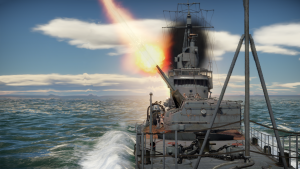
Shimakaze's primary guns are shared with Yugumo and Ayanami, offering the same capabilities and the same shell choice. Despite of being in a higher BR the ship stands a fair chance against its counterparts, though with increasingly challenging opponents and added care has to be put in an accurate gunnery and torpedoes play an even more important role in disposing opponents. But like her parallel predecessor (Yugumo-class), her main armament isn't her selling point at this BR.
Secondary armament
Unlike other early refits of Japanese destroyers, which have very few anti-air defense, the Shimakaze is refitted in her 1944 fit, which gives her well enough air cover at semi-close ranges and desimates smaller patrol vessels within 2km range.
- Universal belts: good balance between firepower and tracer contents, useful for newcomers to the Japanese 25 mm autocannon.
- APT belts: Full of AP shells, good against boats but you might not meet lots of them in destroyer.
- HEI belts: Trades tracer rounds for extra firepower, harder to aim but very good at knocking out aircraft.
Anti-aircraft armament
The Shimakaze has a single 13.2 mm HMG on the stern. Her 25 mm's are responsible for for air cover along with the 13 mm, but can't be manually controlled together with the 25 mm's at the same time.
Torpedo armament
Shimakaze uses the Type 93 Model 3 torpedoes, which have a reduced range of 15 km compared to the standard 20 km Type 93 Model 1 found on other Japanese ships. While not gaining any speed advantage, it does gain an even larger warhead: ~1000 kg of TNT instead of ~600, which makes it possible to sink nearly any destroyer with a single hit.
On top of having one of the best torpedoes, she racks a total of 15 torpedoes she can fire all at once due her lengthened hull compared to the Yugumo-class allowing for heavier quintuple launchers, and an extra 3rd torpedo turret due the added buoyancy.
| Torpedo Characteristics | |||||||
|---|---|---|---|---|---|---|---|
| Mass (kg) | Maximum speed in water (km/h) | Travel distance (km) | Depth stroke (m) | Arming distance (m) | Explosive type | Explosive mass (kg) | TNT equivalent (kg) |
| 2,800 | 91 | 15.00 | 1 | 50 | Type 97 | 780 | 998.4 |
Special armament
Without the presence of submarines, the usage of depth charges is very situational. If using the depth charges that drop off stern racks, there is no reason to use any depth charge activation time setting above the minimum 3 seconds, since higher times means the depth charge will sink further, and thus away from the target. With a fast boat, sailing up right next to a slower target and dropping the depth charges can lead to some success.
The depth charges mounted on depth charge throwers are even more situational. They cannot be aimed and have a long flight time, making them difficult to use against moving targets. Their detonation times also cannot be changed, detonating 3 seconds after hitting the water. They can be used to hit an enemy behind cover, though as with other depth charge uses, this is extremely situational.
Usage in battles
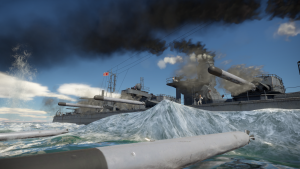
The Shimakaze is one of the most formidable destroyers Japan can offer, owing largely to its outstanding torpedo armament of 3 quintuple launchers and only beaten by Tashkent as 2nd fastest ship in-game.
Otherwise, she has a well-rounded mix of survivability and firepower, lagging behind slightly due to the lack of AP ammunition options, making it cannon fodder for most cruisers if the manoeuvrability isn't made use of. On the contrary, cruisers only have to worry about the Shimakaze like any other Japanese destroyer for the arsenal of torpedoes that will most likely wall them off in a wave of torpedoes and sinking them instantly.
The Long Lance is among the best torpedo in game with excellent range, speed and explosive filler. Like all torpedo-centric destroyers, Shimakaze excels in Arcade Battles with the ability to re-spawn torpedoes mid-battle and is better than other Japanese destroyers which have a 2nd reload for torpedoes which takes a few seconds between torpedo bursts unlike the full burst the Shimakaze can do at once and instantly reload the full rack. Meanwhile in realistic battles torpedoes should be used sparing as you can't reload them out of the capture zone and only reloads one torpedo per torpedo turret.
Modules
| Tier | Seakeeping | Unsinkability | Firepower | |||
|---|---|---|---|---|---|---|
| I | Dry-Docking | Tool Set | 25 mm APT belt | |||
| II | Rudder Replacement | Fire Protection System | Smokescreen | 25 mm HEIT belts | Auxiliary Armament Targeting | 127 mm HE-TF |
| III | Propeller Replacement | Shrapnel Protection | Ventilation | Improved Rangefinder | Primary Armament Targeting | |
| IV | Engine Maintenance | New Pumps | Ammo Wetting | Bomb mortar | ||
Pros and cons
Pros:
- Fastest Japanese destroyer
- Good manoeuvrability
- Top speed of 93 / 76 km/h
- 3 quintuple torpedo launchers
- Can release 15 torpedoes at once
- Very deadly torpedoes (Type 93 Model 3)
- 127 mm guns have good ballistics
- 21 x 25 mm AA cannons with a lot of ammunition
Cons:
- Average Japanese destroyer turrets (Type 3 (127 mm))
- Slow turret traverse
- 127 mm guns have no AP (only HE and HE-DF)
- 127 mm guns are almost useless against air targets (due to slow traverse)
- Turrets tend to be taken out often
- 25 mm AA only effective at close range (max range about 3 km)
History
Devblog
Shimakaze was ordered in 1939 as a prototype vessel of the future Type C destroyers, of which 16 were planned for construction. Shimakaze’s basic design was based on that of the Kagerō destroyer, with Shimakaze incorporating a new high-performance turbine and three quintuple 61cm torpedo launchers as well as having slightly larger dimensions and displacement as a result.
Laid down in August 1941, Shimakaze was completed in May 1943, being assigned to the IJN 1st Fleet upon her commissioning. Shimakaze’s early service career was marked by taking part in the evacuation of Japanese troops from the Aleutian Islands in July and August as well as escort duties until the end of the year and into early 1944.
After undergoing brief refitting in March 1944, Shimakaze escorted battleship Musashi and heavy cruiser Maya from Kure to Manila. Subsequently, Shimakaze was once again ordered to Kure to undergo another refit, in which her anti-air armament was increased.
In October 1944, Shimakaze formally took part in the Battle of Leyte Gulf, although she didn’t see any action as the ship was loaded with survivors picked up from the sunken Musashi and Maya. In November, Shimakaze was assigned to escort a troop convoy from Manila to Ormoc, later being attacked by American aircraft in the Battle of Ormoc Bay. Shimakaze was severely damaged during the battle, only to explode and sink several hours later.Media
- Shimakaze Devblog Images
See also
- Related development
- Yugumo-class (parallel predecessor)
- Shimakaze-class
- Ships of comparable role, configuration and era
- Kiyoshimo (Yugumo-class)
- Tashkent (Tashkent-class)
- Haida (G63) (Tribal-class)
- Corazziere (Soldati-class)
- Type 1934A (1944) (Type 1934-class)
- Fletcher (Fletcher-class)
External links
- [Devblog] Shimakaze: Fast as the Wind
- [Wikipedia] Japanese experimental destroyer Shimakaze (1942)
- [RV Petrel] IJN Shimakaze wreck
| Japan destroyers | |
|---|---|
| IJN | |
| Momi-class | IJN Momi |
| Mutsuki-class | IJN Mutsuki · IJN Satsuki |
| Fubuki-class | IJN Ayanami |
| Hatsuharu-class | IJN Hatsuharu · IJN Nenohi |
| Shiratsuyu-class | IJN Yuudachi |
| Yugumo-class | IJN Yugumo · IJN Hayanami · IJN Kiyoshimo |
| Shimakaze-class | IJN Shimakaze |
| Akizuki-class | IJN Akizuki · IJN Hatsuzuki |
| JMSDF | |
| Ariake-class* | JDS Yūgure (DD-184) |
| Harukaze-class | JDS Harukaze (DD-101) |
| Murasame-class | JDS Murasame (DD-107) |
| * Modified Fletcher-class destroyers | |
| Squadron ships | |
|---|---|
| Germany | Karl Marx |
| USSR | SKR-7 |
| Britain | HMS Liverpool |
| Japan | IJN Shimakaze |



